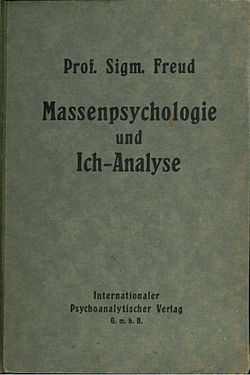Group Psychology and the Analysis of the Ego
 Cover of the first edition of Massenpsychologie und Ich-Analyse | |
| Author | Sigmund Freud |
|---|---|
| Language | German |
| Subject | Psychoanalysis |
| Published | 1921, by Internationaler Psychoanalytischer Verlag ("International Psychoanalytic Publishing House"), Vienna |
| Publication place | Austria |
| Pages | 140 |
Group Psychology and the Analysis of the Ego (German: Massenpsychologie und Ich-Analyse) is a 1921 book by Sigmund Freud, the founder of psychoanalysis.
In this monograph, Freud describes
Freud extensively quotes Le Bon, who explains that the state of the individual in the crowd is "hypnotic", with which Freud agrees. He adds that the contagion and the higher suggestibility are different kinds of change of the individual in de mass.[3]
Freud distinguishes between two types of masses. One is the short-lived kind, characterized by a rapidly transient interest, such as a trend or fad. The other kind consists of more permanent and enduring masses, which are highly organized, such as a religion or the military. "The masses of the former type, so to speak, ride on the latter, like the short but high waves on the long swell of the sea."[4] However, the same basic mental processes operate in both kinds of masses.
Freud refers back to his theory of instincts and believes that masses are held together by libidinal bonds. Each individual in the mass acts on impulses of love that are diverted from their original objectives. They pursue no direct sexual goal, but "do not therefore work less vigorously".[5][6]
Freud initially called the (largely unconscious)
Thus, Freud came to the conclusion: "A primary mass is a number of individuals who have put one and the same object in place of their ego ideal and consequently identify with each other."[9][10]
See also
Notes
- ^ German: "provisorisches Wesen, das aus heterogenen Elementen besteht, die sich für einen Augenblick miteinander verbunden haben"
- ^ German: "impulsiv, wandelbar und reizbar. Sie wird fast ausschließlich vom Unbewussten geleitet."
- ^ German: "(...) daß die beiden letzten Ursachen der Veränderung des Einzelnen in der Masse, die Ansteckung und die höhere Suggerierbarkeit, offenbar nicht gleichartig sind, da ja die Ansteckung auch eine Äußerung der Suggerierbarkeit sein soll."
- ^ German: "Die Massen der ersteren Art sind den letzteren gleichsam aufgesetzt wie die kurzen, aber hohen Wellen den langen Dünungen der See."
- ^ German: "ohne darum minder energisch zu wirken"
- ^ Freud 2005, p. 66.
- ^ German: "liebt es wegen der Vollkommenheit, die man fürs eigene Ich angestrebt hat"
- ^ Freud 2005, p. 74.
- ^ German: "Eine primäre Masse ist eine Anzahl von Individuen, die ein und dasselbe Objekt an die Stelle ihres Ich-Ideals gesetzt und sich infolgedessen miteinander identifiziert haben."
- ^ Freud 2005, p. 78.
References
- Freud, Sigmund (2005). Massenpsychologie und Ich-Analyse. Die Zukunft einer Illusion [Group Psychology and the Analysis of the Ego: The Future of an Illusion] (in German). ISBN 978-3596104529.
External links
- Digitized version of the first edition of the book at archive.org
- Gustave Le Bon. Books. Project Gutenberg (En; Fr)
- Sigmund Freud. Group Psychology and The Analysis of The Ego. Project Gutenberg (En)
